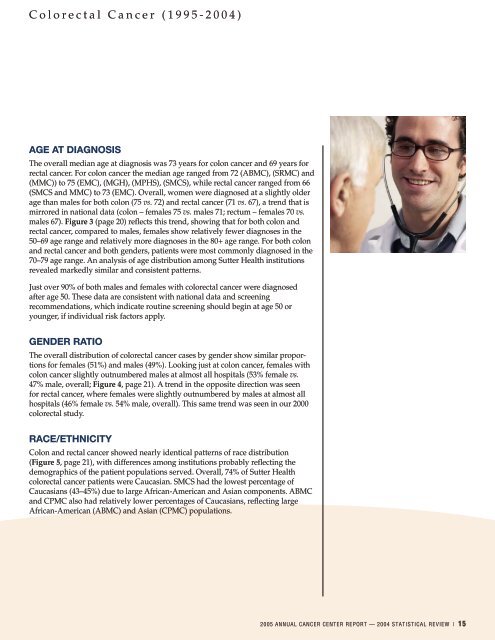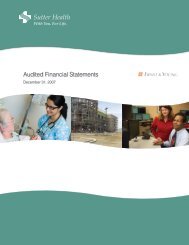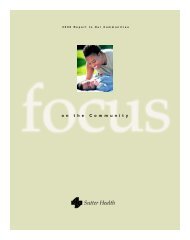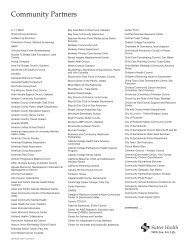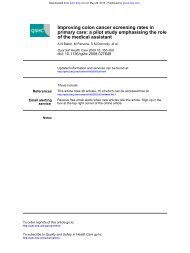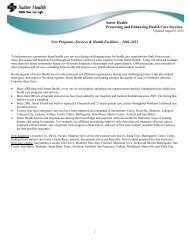C o l o r e c t a l C a n c e r ( 1 9 9 5 - 2 0 0 4 )FOCUSat <strong>Sutter</strong> <strong>Health</strong>OverviewThe American <strong>Cancer</strong> Society estimates that in the United States there will be145,290 new cases of colorectal cancer diagnosed in 2005, <strong>and</strong> that 56,290 peoplewill die of the disease. Colorectal cancer remains the third most common cancerin both men <strong>and</strong> women, following lung cancer <strong>and</strong> either prostate or femalebreast cancer. It is still the third most common cause of cancer-related death foreach gender. However, when cancer deaths for both sexes are combined, the totalnumber of deaths due to colon <strong>and</strong> rectal cancer is larger than for either prostate orbreast cancer individually.Michael Cassidy, MDMedical DirectorAlta Bates Comprehensive <strong>Cancer</strong> CenterEric Gold, Oncology Analyst/ProgrammerAlta Bates Summit Medical CenterSee page two for abbreviations for<strong>Sutter</strong> <strong>Health</strong> institutions.National incidence rates of colorectal cancer have declined since 1998, partly due toincreased screening <strong>and</strong> early polyp removal. 1 Mortality rates from colorectal cancerhave continued to decline in both men <strong>and</strong> women over the past 15 years, reflectingthe decreasing incidence rates since the mid-1980s <strong>and</strong> improvements in survival(Figure 1).1975 1980 1985 1990 1995 200080708070In 2004, among the nine cancer centers in the <strong>Sutter</strong> <strong>Health</strong> Network, colorectalcancer was the fourth most common malignancy overall (10.4%; behind breast,prostate <strong>and</strong> lung); more than 850 new cases were seen. With early diagnosis, thisdisease is highly curable. Due to the common nature of this malignancy <strong>and</strong> thepotential benefits derived from both early diagnosis <strong>and</strong> appropriate therapy,we have chosen colorectal cancer as the focus of the 2005 <strong>Sutter</strong> <strong>Health</strong> <strong>Cancer</strong><strong>Programs</strong> Annual Report. This review can be considered a follow-up to the studypresented in the 2000 <strong>Sutter</strong> <strong>Health</strong> <strong>Cancer</strong> <strong>Programs</strong> Annual Report, whichreviewed colorectal cancer cases accessioned from 1989 through 1999.This analysis examines 7,877 new cases of invasive colorectal adenocarcinomadiagnosed <strong>and</strong>/or receiving first course of treatment at the nine <strong>Sutter</strong> <strong>Health</strong>institutions from 1995–2004. For the purposes of this study, colon cancers weredefined as those malignancies arising from the following sites: cecum, ascendingcolon, hepatic flexure, transverse colon, splenic flexure, descending colon, sigmoid<strong>and</strong> rectosigmoid. Rectal cancer was limited to cancers found in the rectum.Figure 2 (page 20) shows the volume distribution of colon <strong>and</strong> rectum cases amongthe <strong>Sutter</strong> <strong>Health</strong> hospitals, generally mirroring the size of the underlying oncologypopulation at each of these institutions.During the 10-year span of this study, 6,282 colon cancers <strong>and</strong> 1,595 rectal cancerswere noted, representing 80% <strong>and</strong> 20%, respectively, of the total colorectal cancercases. During this time period, the nine ACoS-accredited <strong>Sutter</strong> <strong>Health</strong> hospitalsshowed similar relative incidence of colorectal cancer — approximately 10% of allanalytic cases (with colon accounting for 8% <strong>and</strong> rectal accounting for 2% of analyticcases).Rate pe r 100,000605040302010Male IncidenceFemale IncidenceMale MortalityFemale Mortality001975 1980 1985 1990 1995 2000Year o f Diagnosis/De athFigure 1Focus on Colorectal <strong>Cancer</strong>: 1995–2004<strong>Sutter</strong> <strong>Health</strong> 2005 <strong>Cancer</strong> <strong>Programs</strong> Annual ReportU.S. Colorectal <strong>Cancer</strong> Incidence<strong>and</strong> Mortality by Gender1975–2002 (SEER data, NCI, 2005)1Ries LAG, Eisner MP, Kosary CL, Hankey BF, MillerBA, Clegg L, Mariotto A, Feuer EJ, Edwards BK (eds).SEER <strong>Cancer</strong> Statistics Review, 1975–2002, National<strong>Cancer</strong> Institute. Bethesda, MD, http://seer.cancer.gov/csr/1975–2002/, based on November 2004 SEERdata submission, posted to the SEER website 200560504030201014 | 2005 Annual <strong>Cancer</strong> Center Report — 2004 Statistical Review
C o l o r e c t a l C a n c e r ( 1 9 9 5 - 2 0 0 4 )Age at DiagnosisThe overall median age at diagnosis was 73 years for colon cancer <strong>and</strong> 69 years forrectal cancer. For colon cancer the median age ranged from 72 (ABMC), (SRMC) <strong>and</strong>(MMC)) to 75 (EMC), (MGH), (MPHS), (SMCS), while rectal cancer ranged from 66(SMCS <strong>and</strong> MMC) to 73 (EMC). Overall, women were diagnosed at a slightly olderage than males for both colon (75 vs. 72) <strong>and</strong> rectal cancer (71 vs. 67), a trend that ismirrored in national data (colon – females 75 vs. males 71; rectum – females 70 vs.males 67). Figure 3 (page 20) reflects this trend, showing that for both colon <strong>and</strong>rectal cancer, compared to males, females show relatively fewer diagnoses in the50–69 age range <strong>and</strong> relatively more diagnoses in the 80+ age range. For both colon<strong>and</strong> rectal cancer <strong>and</strong> both genders, patients were most commonly diagnosed in the70–79 age range. An analysis of age distribution among <strong>Sutter</strong> <strong>Health</strong> institutionsrevealed markedly similar <strong>and</strong> consistent patterns.Just over 90% of both males <strong>and</strong> females with colorectal cancer were diagnosedafter age 50. These data are consistent with national data <strong>and</strong> screeningrecommendations, which indicate routine screening should begin at age 50 oryounger, if individual risk factors apply.Gender RatioThe overall distribution of colorectal cancer cases by gender show similar proportionsfor females (51%) <strong>and</strong> males (49%). Looking just at colon cancer, females withcolon cancer slightly outnumbered males at almost all hospitals (53% female vs.47% male, overall; Figure 4, page 21). A trend in the opposite direction was seenfor rectal cancer, where females were slightly outnumbered by males at almost allhospitals (46% female vs. 54% male, overall). This same trend was seen in our 2000colorectal study.Race/EthnicityColon <strong>and</strong> rectal cancer showed nearly identical patterns of race distribution(Figure 5, page 21), with differences among institutions probably reflecting thedemographics of the patient populations served. Overall, 74% of <strong>Sutter</strong> <strong>Health</strong>colorectal cancer patients were Caucasian. SMCS had the lowest percentage ofCaucasians (43–45%) due to large African-American <strong>and</strong> Asian components. ABMC<strong>and</strong> CPMC also had relatively lower percentages of Caucasians, reflecting largeAfrican-American (ABMC) <strong>and</strong> Asian (CPMC) populations.2005 Annual <strong>Cancer</strong> Center Report — 2004 Statistical Review | 15


